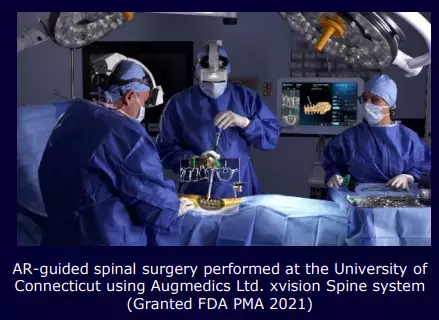The utilization of Augmented (AR), Virtual (VR), and Mixed/Merged Reality (MR) in the medical field provides novel and exciting potential for improving numerous aspects of healthcare delivery—spanning from VR training to AR-assisted surgeries.
AR, VR, and MR are collectively termed Extended Reality (XR). The XR industry segment has seen significant growth, particularly since the beginning of the COVID-19 pandemic due to the sudden importance of virtual and no-contact treatments. The number of XR applications is predicted to rise at a growth rate of 32 % compound annual growth rate (CAGR) through 2027, reaching almost $12 billion globally.1

Image Credit: Radiant Vision Systems
The Landscape of Medical AR/VR
The continual expansion of XR technology can be attributed to its diverse range of applications for both patients and clinicians (see table below). These applications leverage the unique abilities of XR systems, including three-dimensional (3-D) data visualization, integrating data from camera and sensor input, and allowing the user to interact with virtual images.
VR offers an immersive experience with imagery that fills the user’s entire field of vision. Mixed/merged and augmented reality utilize transparent surfaces (for example, smart glasses), to display images while keeping the background environment visible. Both visual modes have proven useful in medical applications.
Source: Radiant Vision Systems
| Education |
Surgery & Treatment |
Rehabilitation |
Pain Management |
Mental Health |
- Anatomy
- Skills training
- Simulated procedures
- Patient interface simulation
|
- Surgical prep/practice
- In surgery
- Robotic surgery
- Operative and post-operative services
|
- Interactive rehabilitation
- Physical therapy
|
- During treatments
- Chronic pain
|
- PTSD
- Anxiety
- Phobias
- Procedure anxiety (e.g., children undergoing treatments)
|
These applications were explored comprehensively by Radiant Vision Systems in a 2022 blog post. For instance, doctors are employing medical imaging data to create 3-D visualizations of patient anatomy to plan and perform surgeries. Medical students can also study the intricacies of the human heart using an interactive VR model. For patients, the immersive nature of VR can help alleviate pain or be utilized as a tool for physical therapy/patient rehabilitation.
For those suffering from trauma, phobias, or similar mental health issues, VR can help them heal. “Therapists can use these devices to completely immerse their patients in a virtual world or augment their real one with digital tools and experiences that enhance their therapy. In addition, VR and AR devices create a safe space for social interactions in this immersive remote therapy experience.”2
In a 2019 blog post, Radiant Vision Systems explored the applications of Medical XR in the treatment of chronic pain, stroke recovery, brain tumor surgery, and even in reducing pain during the blood drawing process.
Medical XR Quality Considerations
From the start, thorough research and testing of AR/VR systems have been required to guarantee the comfort and safety of human users. As the popularity of XR technologies in the medical industry grows, new quality considerations become apparent. As with any other medical device or system, it is paramount to guarantee the effectiveness and safety of the product when used in a treatment modality.
Various organizations—including the International Electrotechnical Commission (IEC), the U.S. Food and Drug Administration (FDA), and ISO—have acknowledged this matter. The IEC released medical AR/VR system testing and performance standards (IEC 63145 publication series). The FDA created a Medical Extended Reality Program, which necessitates clearance for XR systems. To date, the FDA has approved 39 AR/VR systems for marketing. ISO also appears to be at the cusp of releasing a new standard.

Image Credit: Radiant Vision Systems
Quality Testing AR/VR Devices for Medical Use
In situations where people’s health is on the line, XR designers and manufacturers must ensure the quality and performance of their software and devices. Radiant Vision Systems has worked with several world-leading XR companies to measure and quantify system performance across parameters, including luminance, color (chromaticity), and uniformity.
Radiant Vision Systems has also developed special optical equipment—including the AV/VR Lens and the XRE Lens Solution—which allow customers to precisely test several systems and components to mimic the human user experience.
Radiant's TrueTest™ TT-ARVR Software is designed to automatically run selections from a large library of tests, including distortion, contrast, MTF, and uniformity. The XRE Lens system features an electronic lens that can immediately adjust to variable or multiple focal planes, minimizing measurement time.
The below webinar discusses AR/VR product testing issues, explains the tests and specifications for medical XR systems, and describes successful approaches for ensuring quality.
For more information on the quality considerations for Medical XR systems, and how Radiant Solutions helps to meet testing needs, view the 2023 webinar presented by GlobalSpec, titled “Medical AR/VR: Addressing the Hardware and Software Quality Test Challenges.” It covers:
- The emerging landscape of medical AR/VR, trends, considerations, and key applications.
- Potential optical quality issues that may affect the performance of hardware devices and the software products that run them.
- Performance and quality parameters like luminance, contrast, and color for AR/VR devices and applications.
- The most up-to-date tools and approaches utilized to measure medical and healthcare AR/VR products while also enabling display, device, and system makers to improve quality and increase yields.
References and Further Reading
- Global AR & VR in Healthcare Market Size, Share, Trends...Industry Forecast (2023 to 2028). Market Data Forecast. March 2023
- Hamilton, J., “Seven therapeutic uses of VR and AR devices.” TechTalks, October 9, 2022.

This information has been sourced, reviewed, and adapted from materials provided by Radiant Vision Systems.
For more information on this source, please visit Radiant Vision Systems.